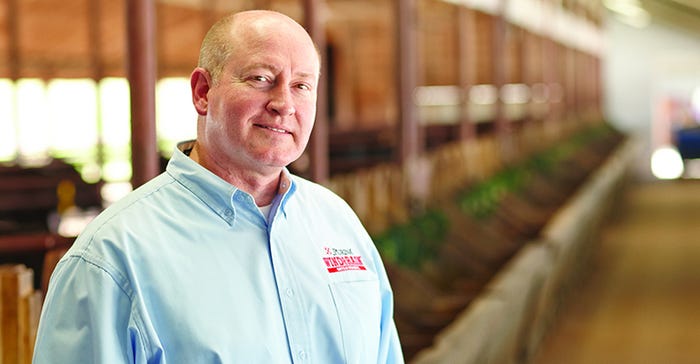The true cost of respiratory challenges in weaned calves
Respiratory challenges can come with longer-term consequences that often go unnoticed, but nutrition strategies can help mitigate impacts.
July 1, 2020

Sponsored Content
Calf health challenges are costly and widespread. And despite improving vaccinations, management practices and genetics, USDA feedlot data shows respiratory challenges aren’t decreasing.

“One in five head1 is affected by respiratory challenges, costing the beef industry about $1 billion annually,"2, 3 says Ron Scott, Ph.D. and beef technical innovations director at Purina Animal Nutrition. “It’s a staggering economic loss, but overcoming it starts at the producer level.”
How much do respiratory challenges cost your operation? Let’s explore.
A cost of up to $75 per calf
Studies show a health challenge could cut a calf’s rate of gain in half for 30 days or more. Assuming healthy calves gain around 3 pounds per day, that’s 45 potential pounds lost per calf.
“And guess what? Health-challenged calves don't catch up,” says Scott. “If days on feed is equal, you’ve lost 45 pounds of out-weight compared to a healthy calf.”
Based on a $1.00 per pound market price, that’s $45 of lost profit per calf. Add an extra $30 for time and money to care for the calf,4 and each health-challenged calf can cost approximately $75.
But, there’s more to the story – beyond the obvious numbers, respiratory challenges can come with longer-term consequences that often go unnoticed.
Overlooked consequences
“Following the same math, if a health-challenged heifer gets bred the first time, she’ll calve 45 pounds lighter than her contemporaries,” says Scott. “And she’s still growing, so it takes more time and energy for her to catch up body condition post-calving.”
A first-calf heifer that is playing catch-up on body condition will have a hard time getting bred back. If she does breed back, it will probably be later in the breeding season. And, the later she gets bred, the further she will fall behind in subsequent breeding seasons.
Additionally, producers who retain ownership could miss out on profit for every health-challenged calf they send to the feedlot.
“Cattle never diagnosed with respiratory challenges have heavier carcasses and more muscle on the rail, meaning a more valuable carcass,”5 says Scott. “But even if you don’t retain ownership, calf health status affects your reputation as a cow/calf producer.”
Healthy cattle build a positive reputation with cattle buyers. A good reputation can result in better prices and less time spent marketing.
Proactive calf health strategies and innovative technology can make having more healthy calves a reality.
Support calves’ immune systems
A focus on calf health should start well before weaning with cow nutrition, proper sanitation, vaccination and low-stress weaning methods.

But, weaning-time stressors combined with a still-developing immune system lower calves’ ability to fight back against disease. That’s why it’s critical to support calves’ immune systems during times of high stress.
A quality, palatable starter feed will get calves eating quickly post-weaning. When calves are eating, their immune systems strengthen, and they have a better chance of staying healthy through weaning. Some starter feeds even come with immune support built in.
An effective starter feed should:
Drive calves to start and continue eating
Maintain calf energy and protein reserves
Build rumen microbe populations
Maintain immune status for fewer sick calves
Support calf performance
When making your starter feed selection, ask questions about palatability and request intake research. Don’t settle for the least expensive option – it might be cheaper up front, but it could also be less effective. Ask for a starter feed that supports calf immune systems.
Ready to give your calves a weaning-time boost? Visit purinamills.com/weaning.
1 Brooks KR, Raper KC, Ward CE, Holland BP, Krehbiel CR, Step DL. Economic effects of bovine respiratory disease on feedlot cattle during backgrounding and finishing phases. Stillwater (OK): Oklahoma State University. Report No.: P-1027. Accessed May 5, 2017. Available from: http://pods.dasnr.o - kstate.edu/docushare/dsweb/Get/Document-6830/P-1027%20Economic%20Effect%20of%20BRD1.pdf.
2 Brodersen BW. Bovine respiratory syncytial virus. Vet Clin North Am Food Anim Pract. 2010;26(2):323-333.
3 Griffin D, Chengappa MM, Kuszak J, McVey DS. Bacterial pathogens of the bovine respiratory disease complex. Vet Clin North Am Food Anim Pract. 2010;26(2):381-394.
4 Assumes a $25 medication cost and $5 labor cost (average hourly wage of $15 and around 20 minutes per calf).
5 Schneider MJ, Tait RG, Busby WD, Reecy JM. An evaluation of bovine respiratory disease complex in feedlot cattle: impact on performance and carcass traits using treatment records and lung lesion scores. J. Anim. Sci. 2009;87:1821-1827.
About the Author(s)
You May Also Like




.png?width=300&auto=webp&quality=80&disable=upscale)
